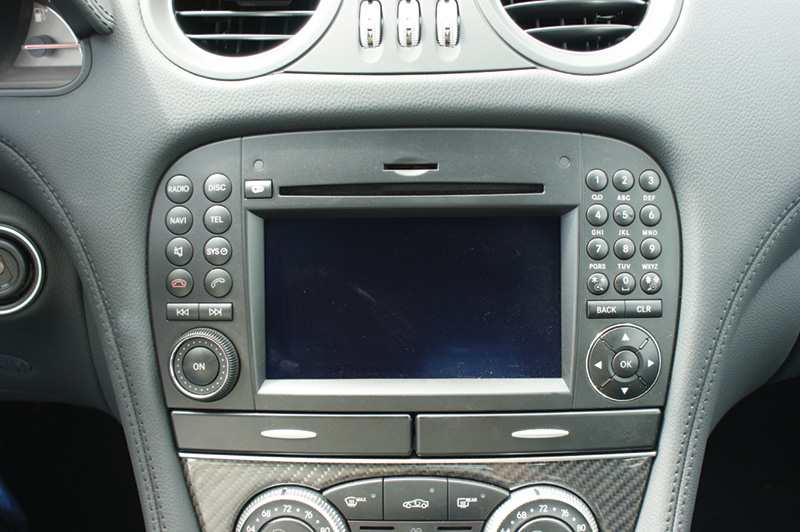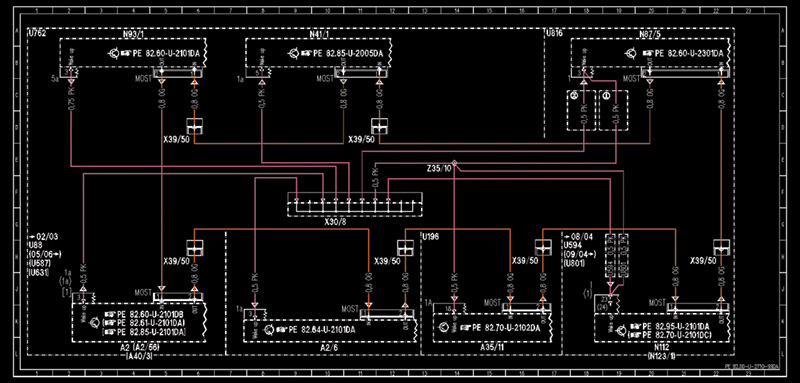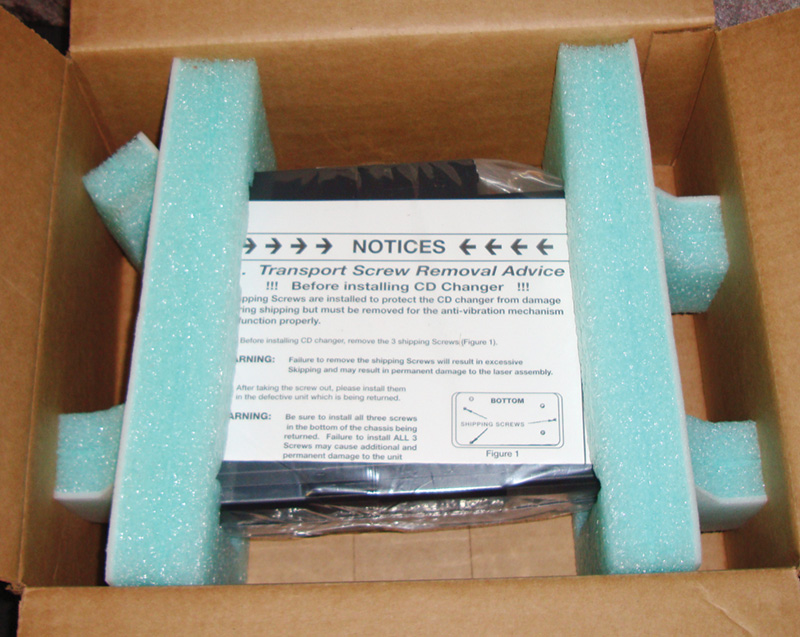The addition of electronics has turned the average vehicle into a technological marvel, but a Mercedes-Benz is no average vehicle. At the cutting edge of technology since its founding, the company has added fiber optics that allow it to process large amounts of digital media. What do we need to know if it stops doing that?

One of the first steps in diagnosing a problem with the MOST bus system is to establish communication with the MOST master control unit. In this case, it is the COMAND® radio. Verify communication first. If you do not have communications, check the fuses, power, and ground to the control unit. If you have communication, you can move on to the next step.
We’ve all seen electronics take hold of our industry. It started with electronic ignition (mandated in 1975), then fuel injection, and now seemingly every component on the car is either controlled or monitored by electronics. This generally makes systems more complicated. There are sensor inputs, a processor, and computer-controlled outputs. While this added complexity can make your life more difficult when something breaks, it can also make it easier.
SDS XENTRY software is designed to interpret the data of the processors and can retrieve diagnostic trouble codes, give you real-time data, and also allow you to bi-directionally control computer outputs so you can find out if the components receiving commands are actually working. Having this information allows you to quickly look at data you may find useful in diagnosing the problem. Once you isolate where the trouble is, you can then do more specific electrical testing to verify your conclusions. You’d feel pretty silly if you spent hours doing high-tech diagnosis only to find out that an electrical connector was not plugged in properly.
Getting the MOST
Nowhere is this technology more evident than in the entertainment system. These have different needs from body control or powertrain systems. Powertrain systems need high-speed data transfer because traction control, engine management, and suspension features need to work together to keep the car under control during spirited driving. Body control systems can operate at a much slower speed and the vehicle’s occupants won’t notice the difference. Entertainment systems do not need high speed, but there is a whole lot of information that needs to be moved around —visual and audio media files are large. This information must be sent from the digital media reader (CD/DVD player), the display screen, and the sound system. If these systems transferred information across electrical lines the wiring involved would have to be very complex. For this and other reasons, Mercedes-Benz has chosen to use fiber optics for transferring digital media.
Fiber-optic systems offer many advantages over conventional electrical wiring. Number one, they are capable of carrying large amounts of data very quickly. Number two, fiber-optic systems send light messages along a cable, so they’re not subject to magnetic interference, or RFI. They do require a discrete fiber-optic line routed with the wiring harness, which does add a level of complexity. Fiber-optic cable is fairly sturdy, however, and is not subject to corrosion from water intrusion as electrical wiring is.
The main rule for routing fiber-optic cable is simply not to bend it enough to crimp it. Usually, you don’t have to worry about the cable unless accident damage has compromised it. In that event, replace it.

With a paid subscription to www.startekinfo.com, you can pull up a chassis-specific wiring diagram. You can compare the wiring to the MOST bus list of control modules and locate each component. Notice that the Orange lines are wired in series. This is the fiber-optic line. The purple wire is the electrical “Star†wiring electrical bus the MOST master uses to see which control units are waking up and which are not.
Master

Locate the first component on the fiber-optic bus and unplug the connection to that unit. When you turn on the ignition key, you should see one of the cables light up with the fiber-optic signal as shown here. Plug it back in and move on to the next control unit until you no longer see the cable light up. This means either the cable is bad, or the control unit before it is not putting out a fiber-optic signal.
Mercedes-Benz started its adoption of fiber-optics with the D2B (Domestic Digital Bus) system, which was developed exclusively by the company. The network is routed in series — there is one fiber-optic cable coming in and another coming out. In order for this system to work, “someone†has to be in charge, so every D2B system has a “master.â€Â This is the one control unit that is in charge of all the others. This is important to know because this is the control unit you are talking to when you communicate with it using the XENTRY diagnostic software. Since the fiber-optic network is routed in series, it is important for the coding of the master control unit to not only know all of the components on the fiber-optic ring, but also the order in which they are connected. Not every D2B system is the same —someone may have ordered a car with or without a multiple-disc CD changer, for example.
Another thing that’s important to know about a series-wound fiber-optic system is that if one component fails it can bring down the whole system. Nothing will work. You may think it would be a big undertaking to diagnose a whole system that is not working, but it is really not that difficult. The first thing you need to establish is communication with the master control unit. In the case of the D2B system, the master is the COMAND® control unit — the interface mounted in the center of the dash. Use your XENTRY software, or equivalent, to try to establish communication with the master. If you do have communication, then you can assess live data about the other control units on the D2B, pull diagnostic trouble codes that may lead you to the problem, or “ping†the control units on the D2B bus and see what answers back.Â
Starting Point
If you do not have communication with the master COMAND® unit, that’s the first thing you must fix. Start with checking power, ground, and the wake-up signal to the control unit. Remember, if the master is not functioning then nothing else will, either. The first thing you should check are the fuses that power up the master COMAND® unit. If the fuses have power, the next step would be to pull the COMAND® unit out and verify the power and ground supply to it — check for damaged or corroded wiring. If you have power and ground, then you may want to put a lab scope on the CAN lines to the COMAND® unit and verify that the scan tool communication signal is making it to the module. If everything is there, then you may simply have a bad COMAND® unit. Mercedes-Benz offers remanufactured units through your Mercedes-Benz dealer’s parts department.
If you have communication with the COMAND® unit, then the diagnosis is even easier. If the system is down, it has probably set a diagnostic trouble code in the COMAND® unit. This will probably lead you to the trouble, but even if it doesn’t there is testing you can perform to isolate the problem. From the master COMAND® unit, you can call up the coding for the unit and you will know what options are installed in the vehicle you are working on. This is a big help in diagnosing the fiber-optic system. What you can do at this point is access the first control unit the fiber-optic signal is sent to and unplug the cable from that control unit. Turn the ignition key on and observe the cable plug. You should see one of the cables blinking. This is the optical wake-up signal from the master.
The Next Step

The MOST bus is programmable with XENTRY software. Remember, if you want to add a component to the MOST bus you need to go into the MOST master and change the coding for the new configuration. You must get the order right in the fiber-optic loop for stable MOST bus operation.
If you see the blinking light, you know the master is putting out the optical wake-up signal. You can then plug the connector back in and move on to the next control unit on the fiber-optic bus. Unplug that connector, turn the ignition key back on, and watch for the same blinks. Keep moving on through the next control units until you no longer observe the blinking. Remember, the fiber-optic network is in series. So, the control unit that you just unplugged is not the one you’re testing. You’re looking for the output signal from the control unit before it’s on the bus. If you no longer see the wake-up call, it is either not coming out of the control unit before it’s in the network, or the cable has a break in it.
You can purchase a special fiber-optic loop tool, which is sort of like a jumper wire. You can plug it into the fiber-optic connector of each control unit on the network. If you turn the key on and the system starts to work, then the control unit you just bypassed is the problem. This does not mean the control unit is necessarily bad. You still need to verify power, grounds, and the wake-up signal at that control unit, starting with the fuses that power it up.
Mercedes-Benz has made diagnosis even easier by backing up the fiber-optic network with an electrical wake-up line. This signal is generated by the master control unit, but it is conventionally wired in parallel. The wake-up signal is sent and each control unit answers on this wake-up line. The control unit that does not respond has failed. This is how the master control unit senses the system failure and sets diagnostic trouble codes. Verify power and ground and you have diagnosed the problem.
Evolution, not revolution
The only real difference between the D2B bus and the next evolutionary stage, the MOST (Media Oriented System Transport), is the communication protocol. The diagnosis is exactly the same. Use XENTRY to compare the electrical wake-up signal and compare it to the fiber-optic network. The two special tools for the D2B and MOST system are inexpensive and available from your local Mercedes-Benz dealer’s part department — remember, they’re happy to help.Â






0 Comments
Trackbacks/Pingbacks